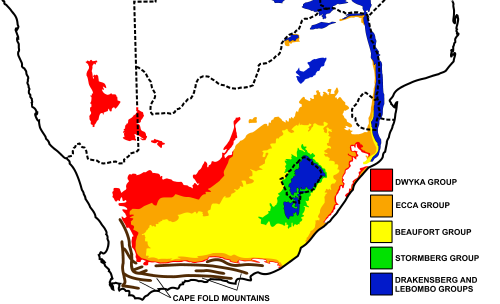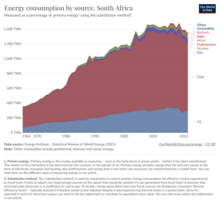Coal in South Africa
 From Wikipedia - Reading time: 14 min
From Wikipedia - Reading time: 14 min
This article needs to be updated. (May 2020) |

As of 2011, South Africa produces in excess of 255 million tonnes of coal[1] and consumes almost three-quarters of that domestically.[2] As of 2018, South Africa was the seventh largest producer and consumer of coal in the world.[3] The industry, as of 2015, employs about 80,000 workers, or .5% of total employment, down from a peak in 1981 of 135,000 workers.[3] The coal industry is South Africa's largest contribution to the greenhouse gases that cause climate change.[4][3]
Around 77% of South Africa's energy needs are directly derived from coal.[5] South Africa is the 5th largest exporter of coal in the world, with 30% consumed overseas.[3] 92% of coal consumed on the African continent is produced in South Africa.[6] 80% of South Africa's CO2 emissions come from the energy supply which is dependent on coal, which produced the vast majority of the country's energy, or 42GWs.[3] In negotiations leading up to the COP26 Climate Conference in Glasgow, South Africa and its partner countries reached a $8.5 billion Climate finance package to end its reliance on coal.[7][8] The use of coal in South Africa dates back to the Iron Age (300–1880 AD), when charcoal (note: not coal, but charred wood) was used to melt iron and copper, but large-scale exploitation of coal did not occur until the mid-19th century.[9]
Geology
[edit]
The largest coal deposits in South Africa are to be found in the Ecca deposits, a stratum of the Karoo Supergroup, dating from the Permian period, between 280 and 250 Ma. The Ecca Group is extensive, covering around two-thirds of South Africa (much of it covered by slightly younger rocks - see diagram on the left). Only the northern and north-eastern portion of these Ecca deposits is coal-bearing, but it nevertheless contains more than a third of all coal reserves in the Southern Hemisphere.[10][11]
Notable coalfields are:
Economic impact
[edit]South Africa is one of the seven largest coal-producing[10][13] and one of the top five coal-exporting[5] countries in the world.
More than a quarter of coal mined in South Africa is exported, most of which leaves the country via Richards Bay.[5] Coal is South Africa's third largest source of foreign exchange; platinum being the largest and gold second.[14] Around 15% of the country's GDP (2000 estimate) is spent on energy[14] and 77% of that is derived from coal.[5]
In 2004, the coal and lignite mining industry generated a gross income of R39 billion and directly employed 50,000 people.[15]
Mining
[edit]The five largest coal mining companies account for around 85% of all production. They are Anglo American plc, South32's South Africa Energy Coal,[16] Sasol Mining, Glencore Xstrata, and Exxaro .[5]
Open-pit mining account for roughly half of South African coal mining operations, the other half being sub-surface.[5]
Coal consumption
[edit]
Electricity generation
[edit]
Electricity in South Africa is mostly generated from coal. Most of the country's coal-fired power stations are in the same province as most of the coal mining, Mpumalanga.[17] Many are expensive and unreliable, and this is part of the cause of South African blackouts.[18]
Liquid fuel
[edit]Around 35% of liquid fuel used in South Africa is derived from coal mined by Sasol Mining at the Secunda CTL plants.[6][19][20]
Household use
[edit]In 1995 around a million lower-income households in South Africa depended on coal as their primary energy source for cooking, lighting and heating.[21] This number has been decreasing steadily during the first decade of the 21st century due to the expansion of electricity supply to lower-income households and rural regions.[22]
Illness and deaths
[edit]
The constitution says that people have a right to “an environment that is not harmful to their health and well-being.”[24]
A 2017 study estimated over 2000 early deaths a year are caused by Eskom's coal-fired power.[25] However Eskom said in 2023 that the number was 330.[26] A 2023 study for all coal power but only PM2.5 estimated 800.[27]
Mining coal and burning it at home can both cause health problems.[28]
Environmental impact
[edit]The government estimated 2020 total greenhouse gas emissions at 442 million tonnes CO2eq.[29] Coal power is estimated to emit about 45% of total GHG.[30]
Environmentalists in South Africa and abroad have criticized the decision of the World Bank's approval for a $3.75 billion loan to build the world's fourth-largest coal-fired power in South Africa. The plant will increase the demand for coal mining and production. Protesters are urging the bank to stop supporting the development of coal plants and other large emitters of greenhouse gas and polluting operations from coal mining.[31]
Some coal mines have been abandoned by their owners, mainly due to companies ceasing to exist. Many of these mines, such as the Transvaal and Delagoa Bay Collieries (T&DB) outside Witbank, have not been rehabilitated prior to being abandoned and are a major source of water and air pollution. It is estimated that clean-up and rehabilitation of the T&DB Collieries will cost around R100 million.[32] Coal seam fires were common, but controlled, at T&DB Collieries during the mine's operation, but the fires have been left to burn out of control since the mine was closed in 1953, to the extent that in 1995 flames could be seen above ground.[33]
See also
[edit]References
[edit]Citations
[edit]- ^ "BP Statistical review of world energy 2012". British Petroleum. Archived from the original (XLS) on 19 June 2012. Retrieved 18 August 2011.
- ^ "Production and consumption of coal (2003 estimates)". Planete Energies. Archived from the original on 13 June 2010. Retrieved 14 January 2010.
- ^ a b c d e "The Carbon Brief Profile: South Africa". Carbon Brief. 15 October 2018. Retrieved 3 August 2020.
- ^ "Carbon dioxide emissions". Department of Environmental Affairs and Tourism (South Africa). Archived from the original on 4 March 2016. Retrieved 15 January 2010.
- ^ a b c d e f "Coal". Department of Energy (South Africa). Retrieved 8 January 2010.
- ^ a b "International Energy Outlook 2009, Chapter 4 - Coal". Energy Information Administration. 27 May 2009. Retrieved 14 January 2010.
- ^ "COP26: South Africa hails deal to end reliance on coal". BBC News. 2 November 2021. Retrieved 2 November 2021.
- ^ "COP26 latest: Europe to invest €1bn in clean technologies such as green hydrogen". Financial Times. 2 November 2021. Archived from the original on 2 November 2021. Retrieved 2 November 2021.
- ^ "Draft EIR Bravo 5" (PDF). Eskom. p. 83. Archived from the original (PDF) on 10 June 2011. Retrieved 14 January 2010.
- ^ a b Schmidt, Stephan. "Coal deposits of South Africa - the future of coal mining in South Africa" (PDF). Institute for Geology, Technische Universität Bergakademie Freiberg. Retrieved 14 January 2010.
- ^ Schlüter & Trauth 2006, p. 214
- ^ a b c d e f "About SA coalfields". Keaton Energy. Archived from the original on 14 June 2009. Retrieved 15 January 2010.
- ^ "Coal Mining". World Coal Institute. Retrieved 14 January 2010.
- ^ a b "HOW ENERGY GENERATION CAUSES ENVIRONMENTAL CHANGE IN SOUTH AFRICA". Department of Environmental Affairs (South Africa). Archived from the original on 16 July 2011. Retrieved 15 January 2010.
- ^ "Mining industry 2004" (PDF). Statistics South Africa. 2004. Retrieved 15 January 2010.
- ^ "South32 - South Africa Energy Coal".
- ^ "South Africa: Little hope in green transition in town with "the dirtiest air in the world"". Mongabay Environmental News. 26 April 2023. Retrieved 9 January 2024.
- ^ "Will South Africa's Power Crisis Sink Its Green Ambitions?". Council on Foreign Relations. Retrieved 9 January 2024.
- ^ "Preliminary study on Sasol fuel plant due in 2008 - CEO". Engineering News (Creamer Media). 8 November 2007. Retrieved 15 January 2010.
- ^ "Sasol orders new reactor as part of Synfuels expansion to meet SA growing demand for fuel". Sasol. 18 November 2007. Archived from the original on 7 August 2011. Retrieved 15 January 2010.
- ^ "Social Impacts on the Environment: # 1". Department of Environmental Affairs (South Africa). Archived from the original on 16 July 2011. Retrieved 15 January 2010.
- ^ "Household energy source". Department of Environmental Affairs and Tourism (South Africa). Archived from the original on 29 October 2009. Retrieved 15 January 2010.
- ^ "As South Africa Clings to Coal, A Struggle for the Right to Breathe". Yale E360. Retrieved 14 December 2021.
- ^ "Air Pollution in South Africa: The Silent Killer That Demands Urgent Action". Greenpeace Africa. Retrieved 9 January 2024.
- ^ "Health impacts of delaying coal power plant decommissioning in South Africa". Centre for Research on Energy and Clean Air. 24 October 2023. Retrieved 9 January 2024.
- ^ "Eskom Says Its Coal Pollution Kills 330 South Africans a Year". www.bloomberg.com. Retrieved 9 January 2024.
- ^ Simelane, Siyabonga P.; Langerman, Kristy E. (17 October 2023). "The sensitivity of health impact assessments of PM2.5 from South African coal-fired power stations". Air Quality, Atmosphere & Health. doi:10.1007/s11869-023-01447-5. ISSN 1873-9326.
- ^ "Outside of Tsakane, South Africa, People Collect Coal Dust to Cook and Stay Warm".
- ^ "Minister Barbara Creecy publishes South Africa's 8th National Greenhouse Gas Inventory Report | South African Government". www.gov.za. Retrieved 9 January 2024.
- ^ "Assessing South Africa's Energy Transition and the implementation of the Integrated Resource Plan" (PDF).
- ^ World Bank approves coal plant is South Africa 9 April 2010 Democracy Now!
- ^ "The True Cost of Coal" (PDF). Greenpeace. p. 53. Retrieved 16 January 2010.
- ^ Limpitlaw; Aken, Lodewijks & Viljoen (13 July 2005). "Sustainable Development in the life of coal mining in South Africa" (PDF). The South African Institute of Mining and Metallurgy. p. 3. Archived from the original (PDF) on 28 July 2020. Retrieved 16 January 2010.
 KSF
KSF
